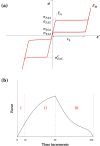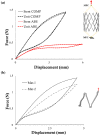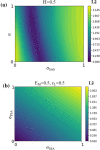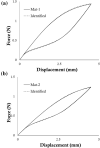Reliable Numerical Models of Nickel-Titanium Stents: How to Deduce the Specific Material Properties from Testing Real Devices
- PMID: 35212855
- PMCID: PMC8917046
- DOI: 10.1007/s10439-022-02932-1
Reliable Numerical Models of Nickel-Titanium Stents: How to Deduce the Specific Material Properties from Testing Real Devices
Abstract
The current interest of those dealing with medical research is the preparation of digital twins. In this frame, the first step to accomplish is the preparation of reliable numerical models. This is a challenging task since it is not common to know the exact device geometry and material properties unless in studies performed in collaboration with the manufacturer. The particular case of modeling Ni-Ti stents can be highlighted as a worst-case scenario due to both the complex geometrical features and non-linear material response. Indeed, if the limitations in the description of the geometry can be overcome, many difficulties still exist in the assessment of the material, which can vary according to the manufacturing process and requires many parameters for its description. The purpose of this work is to propose a coupled experimental and computational workflow to identify the set of material properties in the case of commercially-resembling Ni-Ti stents. This has been achieved from non-destructive tensile tests on the devices compared with results from Finite Element Analysis (FEA). A surrogate modeling approach is proposed for the identification of the material parameters, based on a minimization problem on the database of responses of Ni-Ti materials obtained with FEA with a series of different parameters. The reliability of the final result was validated through the comparison with the output of additional experiments.
Keywords: Digital twin; Material identification; Model validation; Self-expandable stent; Surrogate modeling.
© 2022. The Author(s).
Conflict of interest statement
The authors declare that they no conflict of interest.
Figures








Similar articles
-
Recommendations for finite element modelling of nickel-titanium stents-Verification and validation activities.PLoS One. 2023 Aug 9;18(8):e0283492. doi: 10.1371/journal.pone.0283492. eCollection 2023. PLoS One. 2023. PMID: 37556457 Free PMC article.
-
The impact of modeling choices on the assessment of Ni-Ti fatigue properties through surrogate specimens.Int J Numer Method Biomed Eng. 2023 Sep;39(9):e3753. doi: 10.1002/cnm.3753. Epub 2023 Jul 9. Int J Numer Method Biomed Eng. 2023. PMID: 37424171
-
Shape-Setting of Self-Expanding Nickel-Titanium Laser-Cut and Wire-Braided Stents to Introduce a Helical Ridge.Cardiovasc Eng Technol. 2024 Jun;15(3):317-332. doi: 10.1007/s13239-024-00717-2. Epub 2024 Feb 5. Cardiovasc Eng Technol. 2024. PMID: 38315312 Free PMC article.
-
A Computational Approach for the Prediction of Fatigue Behaviour in Peripheral Stents: Application to a Clinical Case.Ann Biomed Eng. 2016 Feb;44(2):536-47. doi: 10.1007/s10439-015-1472-7. Epub 2015 Oct 3. Ann Biomed Eng. 2016. PMID: 26433586 Review.
-
Research Status and Prospect of Additive Manufactured Nickel-Titanium Shape Memory Alloys.Materials (Basel). 2021 Aug 11;14(16):4496. doi: 10.3390/ma14164496. Materials (Basel). 2021. PMID: 34443019 Free PMC article. Review.
Cited by
-
Determining the Mechanical Properties of Super-Elastic Nitinol Bone Staples Through an Integrated Experimental and Computational Calibration Approach.Ann Biomed Eng. 2024 Mar;52(3):682-694. doi: 10.1007/s10439-023-03416-6. Epub 2023 Dec 27. Ann Biomed Eng. 2024. PMID: 38151644
-
Recommendations for finite element modelling of nickel-titanium stents-Verification and validation activities.PLoS One. 2023 Aug 9;18(8):e0283492. doi: 10.1371/journal.pone.0283492. eCollection 2023. PLoS One. 2023. PMID: 37556457 Free PMC article.
-
Drug Loss at Arterial Bends Can Dominate Off-Target Drug Delivery by Paclitaxel-Coated Balloons.Pharmaceutics. 2025 Feb 4;17(2):197. doi: 10.3390/pharmaceutics17020197. Pharmaceutics. 2025. PMID: 40006564 Free PMC article.
References
-
- Allegretti D, Berti F, Migliavacca F, Pennati G, Petrini L. Fatigue assessment of nickel-titanium peripheral stents: comparison of multi-axial fatigue models. Shape Mem. Superelasticity. 2018;4:186–196. doi: 10.1007/s40830-018-0150-7. - DOI
-
- Arrigoni M, Auricchio F, Cacciafesta V, Petrini L, Pietrabissa R. Mechanical characterisation of orthodontic superelastic Ni-Ti wires. Strain. 2001;11:577–582.
-
- ASME . V&V 40: Assessing Credibility of Computational Modeling Through Verification and Validation: Application to Medical Devices. New York: ASME; 2018.
MeSH terms
Substances
Grants and funding
LinkOut - more resources
Full Text Sources

